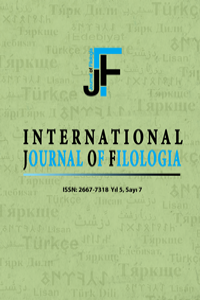A FREUDIAN ANALYSIS OF INDIVIDUAL AND THE CHURCH IN THE MONK BY MATTHEW LEWIS
Kilise ve aristokrasideki var olan sosyal, ahlaki ve dini problemleri resmeden Gotik roman neoklasik dönemin estetik anlayışına eleştirel bir tutum sergiler. Yazıldığı dönemde bir zaman kayması yaşayarak Mathew Lewis The Monk adlı romanında orta çağın kötü insanlarını, baskı altındaki din adamlarını, yoldan çıkmış şeytanı ve günahkâr rahip ve rahibeleri konu alır ve olay örgüsü de kilise ve aristokrat toplumlarında yaşayan insanların karanlık ve problemli yanlarına odaklanır. Lewis sadece görüneni değil aynı zamanda kilisenin hastalıklı ve çelişkili yanlarını da gözler önüne serer. Orta Çağ kilisesinin en sorunlu ve en karanlık yanlarını 18 yy okurlarına anlatmaya çalışır. Bu bağlamda, çalışmamız bu sarmal ilişkiyi Freud’un psikanaliz teorisi kapsamında insanın derin ve karanlık yanlarını ortaya çıkarmak için id (bilinçaltı) ve süper ego terimleri kapsamında inceleyecektir.
Anahtar Kelimeler:
Gotik Roman, Freud, Kötü Karakter, İd, Süperego
SUBCONSCIOUS VILLAIN OF INDIVIDUAL AND INSTITUTIONAL CHURCH IN MATTHEW LEWIS’S THE MONK: FREUDIAN PERSPECTIVE
Depicting the existence of social, ethical, and religious problems in institutional church and aristocracy, many of the novels written in Gothic tradition are critical of the aesthetics of the neoclassical period. Being an anachronistic representation of the period, The Monk by Matthew Lewis is highly critical of the Medieval representation of the Church covering incestuous villains, oppressed religious characters like a villainous monk, seducing demon and evil nuns, the plot structure is an extensive presentation of the dark side of the human and problematic issues taking place in and around the Church along with the presentation of aristocratic life. Lewis presents not only what is visible but also highlights contradictory applications of the Church. This deep and dark relationship is one of the main issues of the Medieval period portrayed by Lewis in the late 18th century. In this context, this study intends to shed light on this interwoven and complicated relationship from a Freudian perspective by highlighting connections, especially between id and superego to reveal hidden and deeper feelings inside human beings.
Keywords:
Gothic novel, Villain, Freud, İd, Superego,
___
- Blakemore, S. (1998). "Matthew Lewis’s Black Mass: Sexual, Religious Inversion in The Monk". Studies ın the Novel. 30.4 521-539.
- Botting, F. (1996). Gothic. Routledge: London.
- Brewer, W. D. (2004). "Transgendering in the Matthew Lewis’s The Monk". Gothic Studies. 6.2. 92-207.
- Cooper, A. L. (2006). "Gothic Threats: The Role of Danger in the Critical Evaluation of The Monk and The Mysteries of Udolpho". Gothic Studies. 8. 2 :18-51.
- Doyle, B. (2000). "Freud and the Schizoid in Ambrosio". Gothic Studies. 2.1: 61-90.
- Ellis, M. (2000). The History of Gothic Fiction. Edinburgh University Press: Edinburgh.
- Fitzgerald, L. (2003). "Crime, Punishment, Criticism". Gothic Studies. 5.1 43-54..
- Hennessy, B. (1978). The Gothic Novel. Ed. Scott-Kilvert Ian. Longman Group Ltd.
- Kilgour, M. (1995). The Rise of the Gothic Novel. Routledge.
- Koç, E. (2005). Birth of English Novel. Çankaya University Publication.
- Lewis, M. (1987). The Monk. Ed. David Stuart Davies. Wordsworth.
- Lui, Y. (2011). "Oedipus Complex in Literature Work". Journal of Language Teaching & Research. Academy Publisher.
- Thurschwell, P. (2000). "Freud’s Maps of the Mind". Sigmund Freud. Routledge Critical Thinking:. 79-93.
- Snodgrass, M. E. (2005). Encyclopedia of Gothic Literature. Facts on File, Inc.: New York, 2005.
- Watkins, D. P. (1986). "Social Hierarchy in Matthew Lewis’s The Monk". Studies in the Novel. 18.2.2021 :115-125.
- ISSN: 2667-7318
- Yayın Aralığı: Yılda 2 Sayı
- Başlangıç: 2018
- Yayıncı: İbrahim Halil TUĞLUK
Sayıdaki Diğer Makaleler
PROSPER MÉRİMÉE’NİN KALEMİNDE MİTLEŞEN BİR KADIN KARAKTER: CARMEN
REDİF BAĞLAMINDA NEDİM DİVANI ÜZERİNE BİR İNCELEME
HÜSEYİN ATLANSOY’UN İNTİHAR İLACI KİTABINDAKİ DİLSEL SAPMALAR
RESÂ’NIN TUHFETÜ’L-EBRÂR ADLI MANZUM TECVİDİ
NEZİHE MERİÇ’İN KORSAN ÇIKMAZI ADLI ROMANINDA TOPLUMSAL CİNSİYET BAKIŞ AÇISIYLA KADIN VE AİLE OLGUSU
Hanife Nalan GENÇ, Feray ŞAHİN
ORHAN PAMUK’UN “VEBA GECELERİ” ROMANINDA ÖLÜM KAYGISI
Mustafa KARABULUT, Ferhat KARASU
KADIZÂDE MEHMED EFENDİ’NİN MEBHAS-I İMAN ADLI ESERİNDE İSİM VE FİİL ÇEKİMİ
HOCA AHMED YESEVÎ’DEN ZÂRÎ’YE CENNET-CEHENNEM MÜNAZARASI
İSİMDEN İSİM YAPIM EKİ +( )Ş’NİN İŞLEKLİĞİ ÜZERİNE
SAVUNMA SANAYİMİZDE YERLİ VE MİLLÎ ASKERİ ARAÇLARA VERİLEN ADLAR
